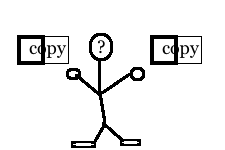 Well, I suppose the title of this article suggests that there IS something difficult to determine about the concept of “fair use.” Perhaps if you thought it was a cut-and-dried topic, then this post is for you. Marty and I have been working with a student video project for a few years now and, each year, we seem to eventually find ourselves in a discussion about copyright and fair use. I went a session at the March KySTE conference about copyright and fair use and, as the presenter rightly noted to all of the dozen or so attendees, people either believe they know how copyright works or else they won’t attend a session for fear of learning about how they’ve violated copyright law.
Well, I suppose the title of this article suggests that there IS something difficult to determine about the concept of “fair use.” Perhaps if you thought it was a cut-and-dried topic, then this post is for you. Marty and I have been working with a student video project for a few years now and, each year, we seem to eventually find ourselves in a discussion about copyright and fair use. I went a session at the March KySTE conference about copyright and fair use and, as the presenter rightly noted to all of the dozen or so attendees, people either believe they know how copyright works or else they won’t attend a session for fear of learning about how they’ve violated copyright law.
Onward, then. What does copyright law have to say about the concept of “fair use”? Here is a link from the U.S. Copyright web site. If only it were as easy as following an exact set of rules. Marty often quotes the “rule of 12”, which means that if 12 jurors deem you guilty of something, then you’re guilty. That’s about as clear as we can get, at times, when it comes to copyright law. The four factors from the copyright site are worth your time, though, and are often used in various training materials on the topic. They are (my emphasis):
- The purpose and character of the use, including whether such use is of commercial nature or is for nonprofit educational purposes
- The nature of the copyrighted work
- The amount and substantiality of the portion used in relation to the copyrighted work as a whole
- The effect of the use upon the potential market for, or value of, the copyrighted work
One item of note. If you’re looking for the “30 second rule“, you won’t find it. I’ve often heard (as recently as a few months ago) that “…as long as you use less than 30 seconds, there is no copyright violation.” As best I can tell, that myth was probably created in an attempt to try to quantify one of the four points noted above. Depending on all of the factors, you could potentially use more than 30 seconds of a work and be just fine. Likewise, you could use only a few seconds and still find yourself in violation of copyright law.
Each case is unique and you probably won’t find a specific answer to your copyright concern. In my brief reading, I’ve noted that there are quite a few relevant sources out there and I believe the information on this difficult topic is becoming more accurate (although perhaps not clearer in the strictest sense of the word). Some relevant links:
Student Press Law Center ‘fair use’ link – I believe this is a site used to give guidance to school-run television broadcasts. Naturally, this is an area where particular attention should be paid to copyright rules, as ‘bump music’ and background tracks are often sought after.
March 2012 KySTE presentation – It’s always scary to go through these things, but the presenter gave permission for this presentation’s use for educational purposes and this may worthy of use if you’re trying to convince someone of this topic’s importance.
Four Points of Fair Use handout – This is part of a free digital citizenship curriculum and it frames the four points above in a slightly different way. There are some good examples in this curriculum and the lessons are pretty informative, though they’ll do more to spark the conversation than they will to give concrete copyright answers.
Checklist from Columbia University on fair use – This checklist may not be the authoritative “yes/no” when it comes to copyright, but it really forces someone to ask some tough questions about their work and the organization of the list really gives you pointers as to whether a factor favors fair use or indicates a copyright concern.
It’s not an easy topic, but hopefully some of these links can be reference on occasion as particular copyright issues arise. Take care!